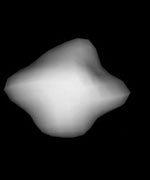
Image credit: ESA
The Hubble Space Telescope has been making detailed observations of Comet 67P/Churyumov-Gerasimenko – the new target for the European Space Agency’s Rosetta mission. The data from Hubble has helped the ESA make precise measurements of the comet’s shape, size and spin-rate so they can fine-tune Rosetta’s flight. If all goes well, Rosetta will launch on February 26, 2004, and then take 10 years to reach the comet. It will orbit the comet and then drop a scientific package onto the surface which should provide scientists with plenty of new data.
Results from the NASA/ESA Hubble Space Telescope have played a major role in preparing ESA?s ambitious Rosetta mission for its new target, comet 67P/Churyumov-Gerasimenko.
Hubble has been used to make precise measurements of the size, shape and rotational period of the comet. Information that is essential if Rosetta is to rendezvous with the comet and then drop down a probe, something never before attempted and yet a major step towards elucidating the origins of the solar system.
Observations made by Hubble in March this year revealed that comet 67P/Churyumov-Gerasimenko (67P/C-G) is approximately five by three kilometres in size and shaped like a rugby ball. ESA mission scientists were concerned about the exact size of the solid nucleus, which is needed to adapt the mission to the comet?s gravity.
“Although 67P/C-G is roughly three times larger than the original Rosetta target, its highly elongated shape should make landing on its nucleus feasible, now that measures are in place to adapt the lander package to the new scenario,” says Dr Philippe Lamy of the Laboratoire d’Astronomie Spatiale in France, who is presenting the Hubble results on comet 67P/C-G today at the annual meeting of the Division for Planetary Sciences of the American Astronomical Society in California, USA.
Mission scientists began looking for an alternative target when the Rosetta mission’s launch date was postponed. The delay meant that the original target comet, 46P/Wirtanen, was no longer easily reachable. But scientists did not have enough information on the back-up comet, 67P/C-G, and sought data from the largest telescopes.
Using a technique developed over the past decade by Philippe Lamy, Imre Toth (Konkoly Observatory, Hungary), and Harold Weaver (Johns Hopkins University Applied Physics Laboratory, Laurel, USA), the team snapped 61 Hubble images of comet 67P/C-G over a period of 21 hours on 11 and 12 March. Hubble’s Wide Field Planetary Camera 2 isolated the comet’s nucleus from the coma, the diffuse gas surrounding the nucleus, quickly providing the figures required. The telescope showed that the nucleus is ellipsoidal and measured its rotation rate at approximately 12 hours.
Rosetta’s launch is currently planned for February 2004, with a rendezvous with the comet about 10 years later.
Original Source: ESA News Release
